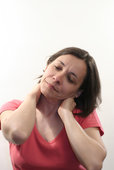The symptoms began, of course, in the middle of the night – high fever, hot to the touch, dripping water, and projectile vomiting of hot greenish liquid. In fact, a geyser of fluid spewed from her overflow tank, rendering the inside of her hood slimy with coolant and her radiator completely devoid of yin fluids. Minnow, my faithful companion of 10 years, was sick.
When she crawled into the doctor in the morning she had improved a bit. The fever was down, though it threatened to return with the slightest exertion. She was able to hold down small amounts of fluid without vomiting. Her complexion showed a hint of blue, and she was unable to maintain her usual speed and vitality.
The doctor (mechanic) stared under her hood, took her pulse (revved her engine), assessed her yin and yang (looked at the coolant level in the radiator and overflow tank), and finally came up with a diagnosis. A busted thermostat.
 A surgeon removed the damaged organ, replacing it with a shiny new part. Yin fluids were restored with just the right blend of water and antifreeze, and my little Mazda “minnow”, whose complexion always tends towards blue, made a full recovery and was sent home.
A surgeon removed the damaged organ, replacing it with a shiny new part. Yin fluids were restored with just the right blend of water and antifreeze, and my little Mazda “minnow”, whose complexion always tends towards blue, made a full recovery and was sent home.
Funny how diagnosing my car parallels diagnosing a human patient. We listen to the symptoms, conduct a physical examination, determine a diagnosis, and move on to a treatment. We’re not always correct – in cars as in people, there are often multiple things which can lead to the same symptoms. A broken radiator hose, malfunctioning water pump, failing thermostat, or a snafu with a cooling fan can all lead to an overheated engine. Gradually the possibilities are narrowed down – if a hose were broken, it is unlikely that the system would pressurize enough to cause a geyser and we could easily see the damaged part. When the engine is turned on, we can see the rotation (or lack thereof) of the fans. We can run tests to separate the water pump from the thermostat, and we can make an educated guess as to which part is the culprit. If replacing one does not fix the problem, the skilled mechanic has a very good idea where to look next.
When a person comes to the acupuncture office with a physical ailment, the same logic is applied to figuring out the root cause of the problem and repairing the damage. A solid clinical interview begins the process. What are the issues? What makes it better or worse? How is the rest of the body functioning? Is sleep or digestion or temperature regulation affected?
 A physical examination is conducted. It may be as simple as looking at a tongue or taking a pulse. It may be as complicated as a full orthopedic and neurologic evaluation with range of motion, muscle strength assessment, and more. Often a skilled practitioner will know what is most likely going on based upon the history, and the physical examination confirms what is already suspected rather than revealing something new.
A physical examination is conducted. It may be as simple as looking at a tongue or taking a pulse. It may be as complicated as a full orthopedic and neurologic evaluation with range of motion, muscle strength assessment, and more. Often a skilled practitioner will know what is most likely going on based upon the history, and the physical examination confirms what is already suspected rather than revealing something new.
Back pain which radiates down the leg may be due to a muscle spasm, a strain or sprain, a bulging disc pressing on a nerve, arthritis, or even a tumor. Constipation may be caused by too little fluid in the digestive system, fluid being absorbed too rapidly, not enough fiber in the diet, poor nerve conduction to the intestines leading to impaired motility, a mechanical blockage of the intestines, and more. There will be subtle differences in the history and exam findings which allow many of the possibilities to be ruled out, and there will often be two or three probable causes remaining. Based on experience and healer’s intuition, an educated guess is made between the remaining possibilities and a treatment plan is developed.
 Unlike the car in which there is only one correct treatment, with people there can be multiple possibilities with minimal differences between them. For example, while it is nice to know for sure that a muscle spasm is the cause of back pain radiating down the leg, the acupuncture points selected will often be nearly identical regardless of which cause turns out to be correct. The empirical points for constipation will be helpful regardless of the reason for this complaint, though the secondary points and perhaps herbal recommendations may be different depending on the cause. The treatment becomes part of the diagnostic process as the practitioner watches what changes in the pulse, the muscle tone of the back, the quality or frequency of bowel movements. The treatment is reassessed at each visit, usually resulting in slight variations on a theme or occasionally a completely different approach, until the complaint resolves and the patient is feeling good again.
Unlike the car in which there is only one correct treatment, with people there can be multiple possibilities with minimal differences between them. For example, while it is nice to know for sure that a muscle spasm is the cause of back pain radiating down the leg, the acupuncture points selected will often be nearly identical regardless of which cause turns out to be correct. The empirical points for constipation will be helpful regardless of the reason for this complaint, though the secondary points and perhaps herbal recommendations may be different depending on the cause. The treatment becomes part of the diagnostic process as the practitioner watches what changes in the pulse, the muscle tone of the back, the quality or frequency of bowel movements. The treatment is reassessed at each visit, usually resulting in slight variations on a theme or occasionally a completely different approach, until the complaint resolves and the patient is feeling good again.
Just as parts wearing out in a vehicle sometimes give warning signs along the way, things can gradually go awry in a human body until the symptoms become glaring obvious and can no longer be ignored. Your mechanic recommends changing the oil every three months or 5000 miles to maintain the health of your car. A skilled acupuncturist can detect early warning signs of things starting to go wrong in your body, and often can use acupuncture and/or an herbal supplement to slow or stop the progression before it is fully broken. A tune-up treatment with the change of seasons can help to minimize the occurrence of major issues and keep your body’s systems functioning optimally.
